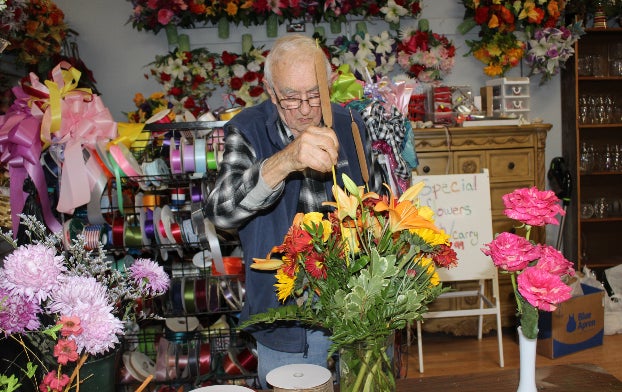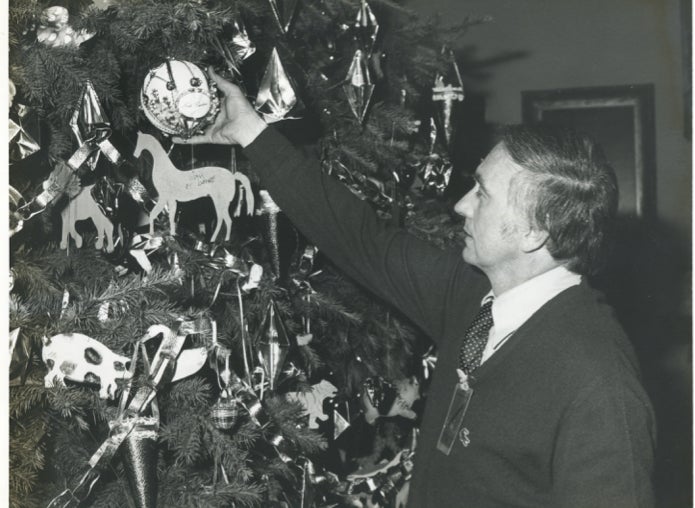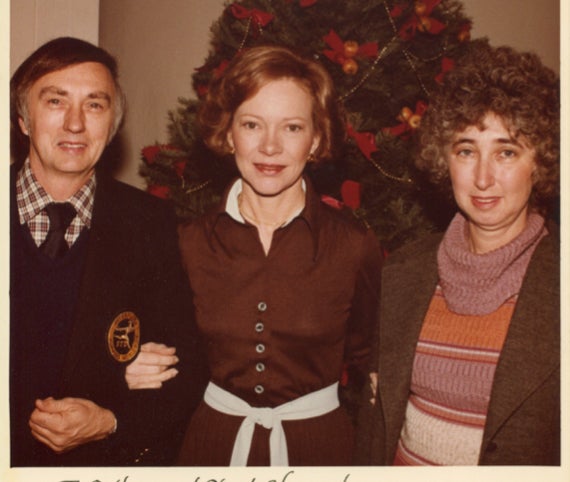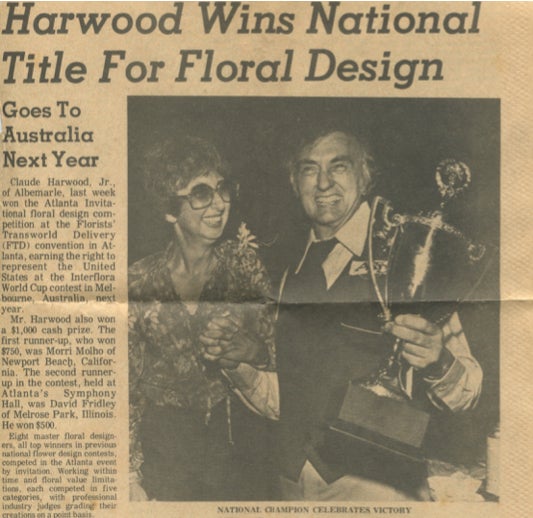STANLY MAGAZINE: A florist and artist, Claude Harwood looks back on his 70-plus year career, including helping decorate the White House
Published 2:00 pm Saturday, November 26, 2022

- Claude Harwood works on a flower arrangement at Blooms Royale Florist in Albemarle.
|
Getting your Trinity Audio player ready...
|
Most people go their whole lives without stepping foot inside the White House or having any type of connection with a presidential administration. The closest they get to seeing the president or his official residence is watching the news on TV.
Claude Harwood Jr., though, is unlike most people.
Harwood, 90, an Albemarle florist who has worked in the industry for more than 70 years, has amassed a litany of impressive accolades, including representing the United States in the Interflora World Cup Competition in Australia in 1979.
But the most memorable moments of his career have centered around his many trips to Washington, D.C., where over the years he helped decorate the White House for the Christmas season during the presidencies of Gerald Ford, Jimmy Carter, Ronald Reagan and George H.W. Bush and helped with the floral arrangements as part of the inaugurations of five presidents, including John F. Kennedy, Lyndon Johnson and Richard Nixon.
“You get to thinking about how privileged you were to be able to do this,” Harwood said.
In honor of all that he’s accomplished and the many customers he has helped over the decades — whether it be for weddings, funerals, anniversaries, proms, birthdays or other occasions — the City of Albemarle honored Harwood with a special recognition during a council meeting in October, including a resolution detailing his many accomplishments.
“Claude Harwood has been a treasure to our city for decades,” Mayor Ronnie Michael later told The Stanly News & Press. “His skill and artistry have served families for generations in times of sorrow, joy and everything in between. His work decorating the White House was a source of immense pride for our community.”
Establishing Himself within the Floral Industry
In many ways, Harwood was always destined to enter into the floral industry. His maternal grandfather operated a floral shop in Tarboro. In 1942, his father opened Harwood’s Florist in Albemarle, along what is now U.S. Highway 52 South, where he originally sold tomato plants.
“My father always loved garden work,” especially growing gladiolus, Harwood said.
As a young kid, Harwood did not necessarily enjoy working in the garden, but he did help his father with the business, where he delivered flowers and worked in the greenhouse.
After high school, Harwood spent one year at N.C. State University, where he took several courses learning about plants and insects typically found within greenhouses.
Following his short stint in Raleigh, Harwood came back to the family business, where he discovered a love for the art of flower arrangements.
“I just liked to work all the time and the older I got, the more I liked the designing part,” he said.
Harwood soon began taking days-long floral designing programs offered across the country, including in Florida, Georgia and California, where he became a sponge, soaking in as much knowledge as possible about the latest industry techniques such as utilizing styrofoam for artificial flowers, making sure stem placements are parallel to each other (known as parallelism) and high-style arrangements.
Wanting to stay on top of the latest trends within the industry, Harwood attended as many programs, he called them schools, as he could before applying what he learned back at Harwood’s Florist. He estimates he attended more than 100 such programs during his career.
“We introduced a lot of the new products in Stanly County,” he said.
Perhaps more important than what he learned was who Harwood was able to network with. These programs — sponsored by the Florists’ Transworld Delivery (FTD), the country’s first floral wire service — helped Harwood establish long-lasting relationships with florists in the United States and across the world.
“It was beautiful because you got to meet a lot of people,” he said about the programs. “These design schools would have designers from other states and sometimes other countries and that’s where you really learn from…people from other places bringing in their techniques.”
Among the many people he met over the years was the German designer and author Gregor Lersch, one of the giants of the industry, whose grandfather was one of the original founders of Interflora, which later became FTD in the United States. He competed against Lersch during his time in Australia and even spent a few weeks with him at his home.
“They confiscated some of his material for the competition and I gave him some of my material, which was unheard of in Europe,” Harwood said.
In his late 20s at the time, Harwood took over the family business along with his mother in 1963, after his father unexpectedly passed away. At that point, Harwood’s Florist, which had numerous greenhouses and six employees, had become a fixture in the community.
“It was overwhelming,” he said about taking over the family business, “but I had been working in the shop long enough that I knew what to do.”
Due to his deep connections within FTD as a result of the many design programs, Harwood gradually became a major player within the industry. Throughout his membership with FTD, he delivered flowers across the country and the world, including to Canada, Germany, Australia and New Zealand.
Mr. Harwood Goes to Washington
His national profile rose even more in late 1960, when FTD contacted him and his wife Cathryn about the opportunity to come to Washington, D.C., to help decorate for the inauguration of John F. Kennedy.
A designer was already in place to coordinate everything; Harwood and the other florists selected helped arrange the flowers.
“They got it all lined up, what they want done, but they got to have somebody that knows how to do it to put it together,” Harwood said.
He spent about five days in Washington, and when a major winter storm occurred the day before the inauguration, Harwood remembers many of the flowers froze.
Though he never got the chance to meet Kennedy, he did briefly meet the new first lady, Jacqueline Kennedy Onassis, though he doesn’t remember any details of the interaction.
Harwood would make six additional trips to the capital over the years, decorating for the inaugurations of Lyndon B. Johnson, Richard Nixon and Jimmy Carter and, later on, going to the White House to help set up Christmas decorations. As was the case with his first visit, Harwood never met the presidents, but did meet their wives — Lady Bird Johnson, Pat Nixon, Betty Ford, Rosalynn Carter, Nancy Reagan and Barbara Bush.
FTD also selected Harwood and his wife to travel to the White House, where they, along with other florists from around the country, helped decorate the official indoor Christmas tree, located in the Blue Room. Harwood helped decorate the tree for four presidents, beginning with Ford and ending with George H.W. Bush.

Claude Harwood decorating the White House Christmas tree during one of his many visits. Photo courtesy of Claude Harwood.
The first indoor Christmas tree was installed in the White House sometime in the 19th century and since 1961 the tree has had a themed motif at the discretion of the First Lady.
“They put a scaffold around the tree and we put up the ornaments,” Harwood said, noting it took several days to decorate the tree each year.
Whenever the president was walking into the Blue Room, which happened on occasion, Harwood and the others would have to clear the room.
Harwood has several pictures of himself decorating at the White House, including one with Cathryn and First Lady Rosalynn Carter, who wrote: “To Cathryn and Claude Harwood, with best wishes.”

Claude and Cathryn Harwood with First Lady Rosalynn Carter, center, at the White House. Photo courtesy of Claude Harwood.
“I was very honored,” he said about being selected multiple times to help decorate for several administrations, spanning about 30 years.
Achieving International Recognition
As wonderful and noteworthy as it was spending time in Washington, arguably the biggest moment of Harwood’s professional career came in 1979, when he represented the United States in Melbourne, Australia as part of the World Cup Competition.
The competition, which was sponsored by Interflora, the international arm of FTD, featured 20 nations and included six categories.
“The entries,” Harwood said in an interview with the SNAP ahead of the competition, “have to be dramatic, different and very showy.”
Harwood became the United States’ representative after he won the national title for floral design, known as Americas Cup, in Atlanta the previous year. Before that, he took first place in the statewide competition.

Claude Harwood took home the national title for floral design in 1978.
Following his victory in Atlanta, Harwood, who had been president of the North Carolina Florists and was North Carolina designer of the year in 1970, went on a national tour sponsored by FTD-Interflora, where he created floral arrangements on television and was interviewed by scores of newspapers. He also participated in floral shows in 14 major cities promoting Interflora, according to the SNAP article.
In preparing for the World Cup, Harwood told the SNAP he received inspiration from all kinds of sources including “plants, people, buildings, cars, our environment.”
FTD-Interflora paid for Harwood’s Australian trip and awarded him $1,000 for winning the national competition.
“A lot of good designers never enter the competition,” Harwood said at the time. “It simply takes a lot of time and it is not a money making thing. You have to love it and love competing.”
Harwood did not win the competition (he does not remember exactly how well he did) as a French florist took the top prize. In the roughly 50 years since the World Cup was first created, no American florist has won the competition, according to the FTD World Cup website.
Harwood as an Artist
As an operator of his floral shop, Harwood has been a businessman, but as a florist, he views himself more as an artist, coming up with new and exciting combinations each time he is given an order.
“Floristry is a curious combination,” he said. “It is a business, but then again you need the artistic ability to come up with different designs all the time.”
Most of the time when receiving orders, customers typically tell him what colors they would like to see and Harwood has the freedom to be as creative as possible in the arrangement and deciding which flowers would best achieve his vision.
He typically reserves certain flowers for certain occasions. For marriages, for example, he tends to include roses and orchids, while with funerals, common flowers include roses, carnations and gladiolus.
Harwood has also made numerous creations out of artificial flowers, including John Deere tractors, tractor trailer trucks and mailboxes.
Besides being a well-known florist, Harwood is also a talented sculptor, as he spent time in the greenhouses creating ceramic snails and ceramic mushrooms, among other creations. His interest with ceramics began as a result of his attraction to masks.
In a 1972 Salisbury Sunday Post article, Harwood estimated he had made about 1,000 mushrooms of different varieties. He started making them about two years earlier.
“I thought it was a good commercial type thing since interior decorators had been using mushroom designs for about three or four years at the time,” he told the Post.
Continuing to work
Even though Harwood closed his family’s shop in 2010, he did not retire from his career as a florist. After having worked for a wholesale florist in Thomasville, he has been working at Blooms Royale Florist in downtown Albemarle for the past four years, creating the same type of arrangements that have made him a beloved fixture in the community.
When asked why he still continues to work, Harwood said he likes to stay busy and continue helping people.
“I’ve enjoyed being with the designers here and the people who work here,” he said. “It’s a real pleasure to continue working.”
The most rewarding part of the job for Harwood has always been the relationships he has cultivated with his customers. And there have been many over the years. He estimates he has helped more than 2,000 people during his time in the business.
That was why the honor of being recognized by the city council, in front of many of his customers in the audience, meant so much to Harwood.
“I am speechless,” Harwood said, holding back tears, as he sat next to Mayor Ronnie Michael. “I appreciate the opportunities that I have had.
“It all boils down to the maker upstairs keeping me here this long to be able to help other people,” he added.





